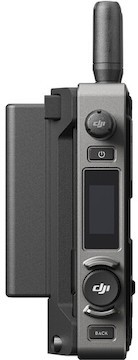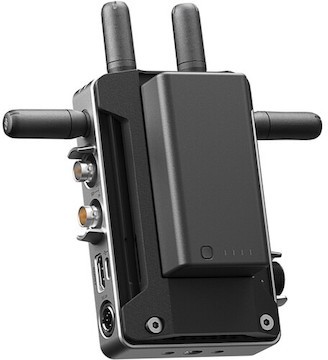The DJI Wireless Video Transmitter transmits high-definition video over 3 miles from your DJI drone or gimbal gear. Key features include:
Works with Ronin 2 / RS 3 Pro gimbals
Power via L-Series battery
Transmits to 2 receivers simultaneously
- O3 pro video transmission technology
High-Definition Transmission. The DJI Wireless Video Transmitter can pair with up to 2 receivers simultaneously in control mode, and in broadcast mode, it can transmit to unlimited receivers with a slightly lower performance. This item incorporates O3 Pro video transmission technology, which offers an incredible 20,000’ on-ground transmission distance. It also supports transmission at 1080p60 with a max bitrate of 50 Mb/s as well as live audio monitoring at 16-bit 48 kHz, ensuring an unmatched remote visual and audio monitoring experience.
Ultra-Low Latency & Auto Frequency Hopping The video transmitter and receiver use the same chip solution as the Ronin 4D, with every link explicitly optimized to provide end-to-end ultra-low transmission latency when pairing with cinema cameras like the ARRI ALEXA Mini LF. The previously mentioned O3 Pro technology adds a Dynamic Frequency Selection (DFS) band on top of the traditional 2.4 and 5.8 GHz, offering up to 23 channel options that provide professional crews with more compliant and interference-free transmission channels. This transmitter supports triple-band automatic frequency hopping, which automatically scans the electromagnetic environment for the the wireless channel that best fits your needs, and a built-in frequency sweeper allows users to manually select a channel to defer any interference between devices. Transmission capabilities are pushed even further when you mount up the high-gain antennas.
Radio, Live Transmission. Control Mode with this device ensures optimal transmission performance, and allows monitoring from two receivers simultaneously while the gimbal of Ronin 2 RS 3 Pro can be controlled remotely. Even in larger and more intense setups, DJI Transmission can operate with 20 or more transmitters sending signals to 20 or more devices, resulting in a smooth, coordinated experience that’s difficult to get with traditional transmission setups.








